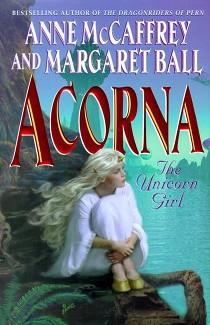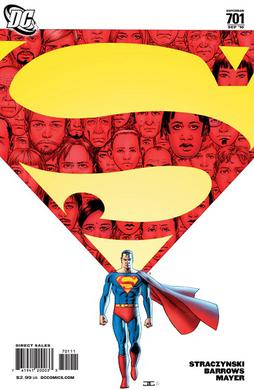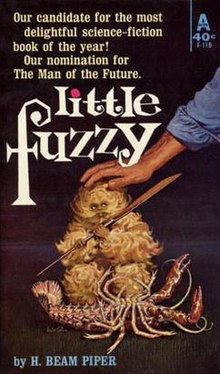
Speaker for the Dead is a 1986 science fiction novel by American writer Orson Scott Card, an indirect sequel to the 1985 novel Ender's Game. The book takes place around the year 5270, some 3,000 years after the events in Ender's Game. However because of relativistic space travel at near-light speed Ender himself is only about 35 years old.
The Riverworld is a fictional planet and the setting for a series of five science fiction novels (1971–1983) by American author Philip José Farmer (1918–2009). The Riverworld is an artificial, or heavily terraformed, planet where all humans who ever lived throughout history have been restored to life. The novels explore interactions of resurrected individuals from many different cultures and time periods. The underlying theme is quasi-religious. The motivations and ethics of the unknown intelligences that created the Riverworld and its inhabitants are explored.

A humanoid is a non-human entity with human form or characteristics. By the 20th century, the term came to describe fossils which were morphologically similar, but not identical, to those of the human skeleton.

Henry Beam Piper was an American science fiction writer. He wrote many short stories and several novels. He is best known for his extensive Terro-Human Future History series of stories and a shorter series of "Paratime" alternate history tales.
Xenosaga is a role-playing video game series developed by Monolith Soft and primarily published by Namco. Forming part of the wider Xeno metaseries, Xenosaga is set in a science fiction universe and follows a group of characters as they face both a hostile alien race called the Gnosis and human factions fighting for control of the Zohar, an artifact connected to a god-like energy called U-DO. Gameplay across the series is similar, with the characters being guided through a linear narrative and fighting enemies using a turn-based combat system. The party fights both on foot and in a variety of mechs.

Dinotopia is a series of illustrated fantasy books, created by author and illustrator James Gurney. It is set in the titular Dinotopia, an isolated island inhabited by shipwrecked humans and sapient dinosaurs who have learned to coexist peacefully as a single symbiotic society. The first book was published in 1992 and has "appeared in 18 languages in more than 30 countries and sold two million copies." Dinotopia: A Land Apart from Time and Dinotopia: The World Beneath both won Hugo awards for best original artwork.

Adventures of Superman is an American television series based on comic book characters and concepts that Jerry Siegel and Joe Shuster created in 1938. The show was the first television series to feature Superman and began filming in 1951 in California on RKO-Pathé stages and the RKO Forty Acres back lot. Cereal manufacturer Kellogg's sponsored the show. The first and last airdates of the show, which was produced for first-run syndication rather than for a network, are disputed, but they are generally accepted as September 19, 1952, and April 28, 1958. The show's first two seasons were filmed in black-and-white; seasons three through six were filmed in color.

Kamandi is a fictional comic book character created by artist Jack Kirby and published by DC Comics. The bulk of Kamandi's appearances occurred in the comic series Kamandi: The Last Boy on Earth, which ran from 1972 to 1978. He is a young hero living in a post-apocalyptic future. Following the Great Disaster, humans have backslid to savagery in a world ruled by intelligent, highly evolved animals.

In Arthur C. Clarke's Space Odyssey series, Monoliths are machines in black cuboids whose sides extend in the precise ratio of 1 : 4 : 9 (12 : 22 : 32) built by an unseen extraterrestrial species whom Clarke dubbed the Firstborn and who he suggests are the earliest highly intelligent species to evolve in the Milky Way. In the series of novels (and the films based on these), three Monoliths are discovered in the Solar System by australopithecines and their human descendants. The characters' responses to their discoveries drives the plot of the series and influences its fictional history, particularly by encouraging humanity to progress with technological development.

Slan is a science fiction novel by American-Canadian writer A. E. van Vogt, as well as the name of the fictional race of superbeings featured in the novel. The novel was originally serialized in the magazine Astounding Science Fiction. It was subsequently published in hardcover in 1946 by Arkham House, in an edition of 4,051 copies. In 2016, Slan was awarded the Retro-Hugo Award for Best Novel for 1941.
The zoo hypothesis speculates on the assumed behavior and existence of technologically advanced extraterrestrial life and the reasons they refrain from contacting Earth. It is one of many theoretical explanations for the Fermi paradox. The hypothesis states that alien life intentionally avoids communication with Earth to allow for natural evolution and sociocultural development, and avoiding interplanetary contamination, similar to people observing animals at a zoo. The hypothesis seeks to explain the apparent absence of extraterrestrial life despite its generally accepted plausibility and hence the reasonable expectation of its existence. A variant on the zoo hypothesis suggested by the former MIT Haystack Observatory scientist John Allen Ball is the "laboratory" hypothesis, in which humanity is being subjected to experiments, with Earth serving as a giant laboratory.

Xenosaga Episode III: Also sprach Zarathustra is a role-playing video game developed by Monolith Soft and published by Namco Bandai Games for the PlayStation 2 in 2006. It is the final entry in both the Xenosaga trilogy and the larger Xenosaga series, which forms part of the Xeno franchise. Concluding the narrative of Xenosaga Episode I and Episode II, Episode III sees Shion Uzuki and the battle android KOS-MOS search out the origins of the hostile alien Gnosis while being hunted by Shion's former employers and four powerful humans called the Testaments. Gameplay is carried over from the first two games, featuring exploration of environments through a linear narrative, while battles follow a turn-based system featuring multiple leveling systems and combat with both a human party and mecha.

Acorna: The Unicorn Girl (1997) is a science fantasy novel by American writers Anne McCaffrey and Margaret Ball. It was the first published in the Acorna Universe series. McCaffrey and Ball wrote the sequel Acorna's Quest after which McCaffrey and Elizabeth Ann Scarborough extended the series almost annually from 1999 to 2007.

Dinotopia is a television miniseries produced by Hallmark Entertainment in association with RTL Television Germany. It is based on the Dinotopia book series by James Gurney, that depicts a fictional utopia in which sapient dinosaurs and humans coexist. The miniseries serves as a sequel to the Dinotopia books, Dinotopia (1992) and Dinotopia: The World Beneath (1995). The main characters of the story are two American teenage boys from contemporary times. The boys' father's plane crashes into the sea and they get stranded on Dinotopia, where they must adjust to a new society. The story in the film contains references to many of the characters in the book series, with some of their descendants occupying key roles in the plot. The original score was composed by Trevor Jones. This score is performed by the London Symphony Orchestra, conducted by Geoffrey Alexander.

Planet of the Apes is an American science fiction media franchise consisting of films, books, television series, comics, and other media about a post-apocalyptic world in which humans and intelligent apes clash for control. The franchise started with French author Pierre Boulle's 1963 novel La Planète des singes, translated into English as Planet of the Apes or Monkey Planet. Its 1968 film adaptation, Planet of the Apes, was a critical and commercial hit, initiating a series of sequels, tie-ins, and derivative works. Arthur P. Jacobs produced the first five Apes films through APJAC Productions for distributor 20th Century Fox; following his death in 1973, Fox controlled the franchise.

"Grounded" is a 2010-2011 comic book story arc that ran through the Superman monthly ongoing series. It was written by J. Michael Straczynski and Chris Roberson, and penciled by Eddy Barrows, with covers by John Cassaday.

Fuzzy Nation is a 2011 novel by John Scalzi, described as a reboot of H. Beam Piper's 1962 novel Little Fuzzy.

Fuzzy Ergo Sum is a 2011 science fiction novel by Wolfgang Diehr as a sequel to H. Beam Piper's Fuzzy trilogy: Little Fuzzy, Fuzzy Sapiens, and Fuzzies and Other People. The trilogy concerns the discovery of a primitive species of small, childlike but sapient furry creatures on Zarathustra, a frontier planet with valuable mineral deposits, and the subsequent conflicts this generates between the Fuzzies, the humans who befriend them, and those who would exploit the Fuzzies and their land. Fuzzy Ergo Sum begins shortly after the conclusion of the trilogy, involving characters from those books in further adventures and conflicts. The story ends in a cliffhanger, and is concluded in Diehr's Caveat Fuzzy.
The Race Betterment Foundation was a eugenics and racial hygiene organization founded in 1914 at Battle Creek, Michigan by John Harvey Kellogg due to his concerns about what he perceived as "race degeneracy". The foundation supported conferences, publications, and the formation of a eugenics registry in cooperation with the ERO. The foundation also sponsored the Fitter Families Campaign from 1928 to the late 1930s and funded Battle Creek College. The foundation controlled the Battle Creek Food Company, which in turn served as the major source for Kellogg's eugenics programs, conferences, and Battle Creek College. In his will, Kellogg left his entire estate to the foundation. In 1947, the foundation had over $687,000 in assets. By 1967, the foundation's accounts were a mere $492.87. In 1967, the state of Michigan indicted the trustees for squandering the foundation's funds and the foundation closed.















